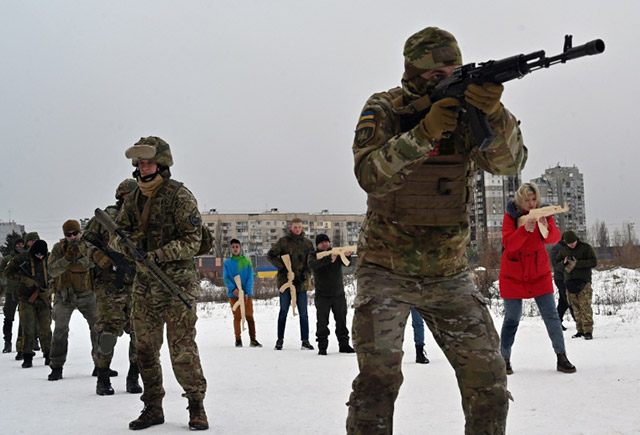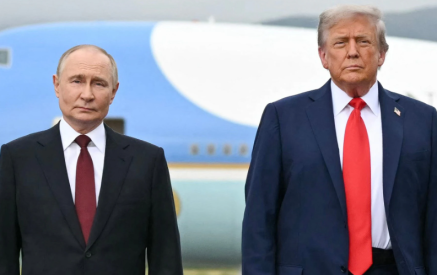By Gulnoza Said/CPJ Europe and Central Asia Program Coordinator
As world leaders launch diplomatic offensives to try to stave off a possible Russian invasion of Ukraine, Ukrainian journalists are preparing to cover a conflict that could take a catastrophic toll on their country.
Russia’s amassing of troops at its neighbor’s eastern border follows its annexation of Ukraine’s Crimean peninsula in 2014 — a move rejected by Ukraine and the international community – after Ukraine’s former president, the pro-Russia Victor Yanukovych, was ousted in a revolution that year.
Ukraine also claims that since 2014 Russia has backed pro-Russian separatists in the Donbass region of eastern Ukraine, though Russia denies that its soldiers went there on national orders.
Read also
The 2014 war in Ukraine’s east posed enormous challenges for journalists — several were taken hostage by pro-Russian separatists and others were killed or wounded in crossfire. In Crimea, Kremlin-controlled authorities have obstructed and closed independent media outlets and imprisoned journalists.
To get a sense of how local journalists are viewing the prospect of another war, CPJ spoke to Anastasiya “Nastya” Stanko, co-founder and former chief editor of independent Ukrainian media channel Hromadske and CPJ’s International Press Freedom awardee in 2018. Stanko, who is now in an advisory role at Hromadske, was taken hostage for several days by pro-Russian separatists when she reported form Donbass in 2014.
CPJ also spoke with Sergiy Tomilenko, head of the National Union of Journalists of Ukraine (NUJU), a local trade union.The interviews have been edited for length and clarity.
In recent months, there has been a flurry of international coverage of a possible Russian invasion. What does it look like from the ground?
Anastasiya Stanko: In December, I went to Donbass near the front line. A couple of weeks ago, I visited Kharkiv. There have been reports that Kharkiv, which is a large city with over a million of people, will be one of the first to be invaded in eastern Ukraine. Russian troops have been building up near the border since April 2021. So, it’s very strange that [only] in October and November 2021, [Western] media started reporting about a possible invasion. We, journalists in Ukraine, were surprised because we didn’t see anything new or different from the situation of a few months earlier.
How do the present tensions differ from the weeks leading up to the 2014 war in Donbass and the occupation of Crimea?
The biggest difference is that nobody expected to see Russian troops in Crimea or Donbass in 2014 until the moment the invasion started. Today, there is no element of surprise, everybody talks about it, expects something, and journalists – both Ukrainian and international – go to the border area.
Unlike their foreign colleagues, Ukrainian journalists haven’t been writing about an imminent war because we don’t see anything new in the situation. But we see that some foreign correspondents gained access to the so-called People’s Republic of Luhansk and People’s Republic of Donetsk [Donbass’ self-proclaimed independent regions, which are controlled by pro-Russian separatists] and they are reporting from there. That’s a positive development because, for years, we only saw the situation in those regions through Russian eyes [as Russian media outlets replaced Ukrainian ones since 2014].
With so much coverage of the potential invasion, do you see more awareness and preparedness among journalists and the international community?
On the one hand, it’s good for Ukraine because Ukraine’s partners, foreign governments, want to help. On the other hand, it’s bad for the Ukrainian economy, for investments. People in Ukraine are quite scared. Nobody knows what will happen next. For example, I am sitting in my apartment in Kyiv and don’t know if I can buy, say, a sofa [because I may have to flee]. You can’t plan even the smallest things.
Another problem is that you can’t know who is telling the truth. For example, our president and officials say certain things, like Kharkiv may be invaded, but we don’t know for sure. Or [some foreign politicians] say the war is imminent. There are a lot of assumptions, predictions, and analysis but very few facts.
How have your colleagues at Hromadske and other media outlets been preparing for a possible conflict?
In early January, they started getting helmets, vests, new first aid kits, and cell phones for emergency phone calls. They have training on how to go to shelters in case of bomb attacks. Also, my colleagues at Hromadske have been trying to find a new office because the current one is not very safe from bomb attacks.
But there are some media outlets that haven’t done any major prep work. I heard from a journalist friend who said their outlet is only working on an alternative website in case the internet or their website will be shut down.
What are your recommendations for reporters who plan to cover an escalation?
The most important thing is to remain a journalist. War is the kind of situation when you feel compelled to choose a side. As a Ukrainian journalist and a Ukrainian citizen, you may feel like you should be on the side of the Ukrainian army. Remain a journalist.
As a war correspondent, you can feel passionate, you can feel like the war is the most important thing and that it’s cool to be in the war zone. You can feel like this is real life, these are real people, and you can start feeling like this is normal. But war is a disgusting thing. It’s never normal.
I recommend that journalists focus more on ordinary people, civilians, because they are the most important people in any war, they suffer the most.
Even today, you can go and see people who live between two frontlines or near the frontline. They are mostly very old, without money, without electricity, without a place to go, without anything. They’ve lived in these conditions for eight years. I think they should be the main topic of reports from these areas. Journalists should give them more airtime, more attention. Give them a voice.
What are the main risks been for journalists covering Donbass and Crimea?
Sergiy Tomilenko: In such regions, journalists are at risk of illegal arrests, kidnappings, and hostage-taking. For many journalists, this is the main danger, which exceeds even the risk of injury in a war zone. If [Ukrainian] journalists go there, they must prepare materials under a pseudonym and work without accreditation.
Journalists who worked in Donetsk and Luhansk in 2014 worked secretly during protests, filmed what was happening on their phones, and found safe places from where they could livestream.
NUJU has several protection kits with helmet and body armor marked “Press”. Any journalist can rent them for free. One kit is in Kyiv, and three kits are in Mariupol [in Donetsk]. We also organize safety training for journalists.
In 2014, there were very few journalists in Ukraine with experience in war zones, but in the last eight years, many journalists have accumulated such experience.
You also need to be careful with sources of information. It is necessary to keep in touch with the editorial office and report your whereabouts at regular intervals. If journalists move by car, they need a local guide or a local driver who knows the roads, because the navigator can route to a “gray” zone [an area not marked on a map].
What other challenges for Ukrainian journalists do you expect might arise?
Journalists and editorial offices will be at greater risk if riots or other hostilities start. The main challenges will be how to work when communication is disconnected, such as when internet access is blocked or electricity shut off. In addition, there is a low level of digital security and media literacy among journalists and the general population.
There are also health risks, especially with COVID-19 and a potential lack of access to medical care. Journalists may lack experience in first aid and the use of first aid kits. Journalists will face a heavy load of psychological trauma.
Gulnoza Said is a journalist and communications professional with over 15 years of experience in New York, Prague, Bratislava, and Tashkent. She has covered issues including politics, media, religion, and human rights with a focus on Central Asia, Russia, and Turkey.
Committee to Protect Journalists




















































